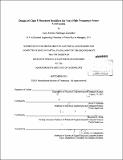| dc.contributor.advisor | David J. Perreault and Khurram K. Afridi. | en_US |
| dc.contributor.author | Santiago-GonzáIez, Juan Antonio | en_US |
| dc.contributor.other | Massachusetts Institute of Technology. Department of Electrical Engineering and Computer Science. | en_US |
| dc.date.accessioned | 2014-02-10T16:55:47Z | |
| dc.date.available | 2014-02-10T16:55:47Z | |
| dc.date.issued | 2013 | en_US |
| dc.identifier.uri | http://hdl.handle.net/1721.1/84862 | |
| dc.description | Thesis (S.M.)--Massachusetts Institute of Technology, Dept. of Electrical Engineering and Computer Science, 2013. | en_US |
| dc.description | Cataloged from PDF version of thesis. | en_US |
| dc.description | Includes bibliographical references (pages 113-116). | en_US |
| dc.description.abstract | Resonant rectifiers have important applications in very-high-frequency power conversion systems, including dc-dc converters, wireless power transfer systems, and energy recovery circuits for radio-frequency systems. In many of these applications, it is desirable for the rectifier to appear as a resistor at its ac input port. However, for a given dc output voltage, the input impedance of a resonant rectifier varies in magnitude and phase as output power changes. In this thesis, a design method is introduced for realizing single-diode "shunt-loaded" resonant rectifiers, or class E rectifiers, that provide near-resistive input impedance over a wide range of output power levels. The proposed methodology is demonstrated experimentally for 10:1 and 2:1 power range ratios at 30 MHz input frequency. Some design limitations are found and explained. Additionally, the performance of Schottky diodes in very high frequency (VHF) rectifiers is explored. It has been found that diodes have increased losses when switched at VHF and this phenomenon varies by manufacturer and device specifications. A study of diodes in Class E rectifiers is conducted to assess their performance in VHF rectification. Some good diodes are identified for VHF operation, including both commercial Si and SiC Schottky diodes and experimental GaN diodes. The foundations are laid for developing a library of diodes useful for this application. The resonant rectifier design methodology presented in this thesis uses a graphical approach based on normalized design curves. It enables a fast design with only a small amount of calculations needed and yields good accuracy in the final circuit. It is hoped that this design approach and the insights available from the design curves will prove to be useful in designing resonant rectifiers in applications that require resistive rectifier loads. | en_US |
| dc.description.statementofresponsibility | by Juan Antonio Santiago-GonzáIez. | en_US |
| dc.format.extent | 116 pages | en_US |
| dc.language.iso | eng | en_US |
| dc.publisher | Massachusetts Institute of Technology | en_US |
| dc.rights | M.I.T. theses are protected by
copyright. They may be viewed from this source for any purpose, but
reproduction or distribution in any format is prohibited without written
permission. See provided URL for inquiries about permission. | en_US |
| dc.rights.uri | http://dspace.mit.edu/handle/1721.1/7582 | en_US |
| dc.subject | Electrical Engineering and Computer Science. | en_US |
| dc.title | Design of class E resonant rectifiers for very high frequency power conversion | en_US |
| dc.type | Thesis | en_US |
| dc.description.degree | S.M. | en_US |
| dc.contributor.department | Massachusetts Institute of Technology. Department of Electrical Engineering and Computer Science | |
| dc.identifier.oclc | 868323433 | en_US |
